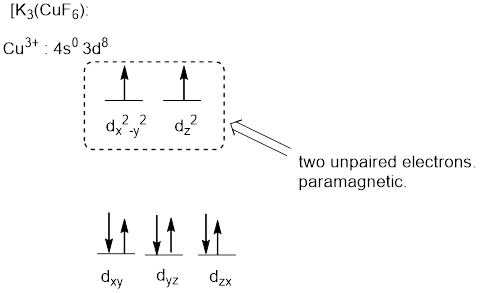
Concept explainers
(a)
Interpretation: To determine the magnetic property of the given compounds.
Concept Introduction:
Spectrochemical series: The list of ligands arranged in an ascending order of
Crystal field splitting: The energy gap between the splitting of d-orbitals of the metal ion in presence of ligands is known as the crystal field splitting
To Identify: To determine the magnetic property of the given compounds.
(a)
Answer to Problem 22.80QP
The
Explanation of Solution
Interpret the given information.
The
(b)
Interpretation: To determine the magnetic property of the given compounds.
Concept Introduction:
Spectrochemical series: The list of ligands arranged in an ascending order of
Crystal field splitting: The energy gap between the splitting of d-orbitals of the metal ion in presence of ligands is known as the crystal field splitting
To Identify: To determine the magnetic property of the given compounds.
(b)
Answer to Problem 22.80QP
The systematic name of the given compound
Explanation of Solution
Interpret the given information.
The systematic name of the given compound
The six ligands around the metal ion give octahedral geometry.
Magnetic property of the compound:

The high field complex ion possesses eight d-electrons and the two electrons are unpaired and exhibits paramagnetic.
(c)
Interpretation: To determine the magnetic property of the given compounds.
Concept Introduction:
Spectrochemical series: The list of ligands arranged in an ascending order of
Crystal field splitting: The energy gap between the splitting of d-orbitals of the metal ion in presence of ligands is known as the crystal field splitting
To Identify: To determine the magnetic property of the given compounds.
(c)
Answer to Problem 22.80QP
The square-planar geometry will be diamagnetic in nature.
Explanation of Solution
Interpret the given information.
In complex ion of

In complex ion of
Want to see more full solutions like this?
Chapter 22 Solutions
CHEMISTRY:ATOMS FIRST (LL)>CUSTOM PKG.<
- what was the pH of gastric juice obtained 5.0ml sample of gastric juice taken from a patient several hours after a meal and titrated the juice with 0,2M NaOH t neutrality the neutralization of gastric HCL required 5.0ml NaOH what was the pH of gastric juice?arrow_forwardPlease correct answer and don't used hand raitingarrow_forward2. Freckles (F) are dominant to no freckles (f). A heterozygous mother ( father ( have a baby. F = freckles, f= no freckles Genotype Phenotype Possibility 1: Possibility 2: Possibility 3: Possibility 4: and heterozygousarrow_forward
- Don't used hand raitingarrow_forwardPlease correct answer and don't used hand raitingarrow_forwardthe rotational constant of HI is 6.511 cm-1. (i)What is the characteristic rotational temperature of HI? (ii) Evaluate the rotational partition function and the mean rotational energy of HI at 298K. Note that T=298K is much larger than the characteristic rotational temperature of HI.arrow_forward
- 3. The ability to roll your tongue (R) is a dominant trait. A woman who cannot roll her tongue ( ) has a baby with a man who is homozygous dominant for this trait ( R = can roll tongue, r = cannot roll tongue ). Possibility 1: Possibility 2: Possibility 3: Possibility 4: Genotype Phenotypearrow_forwardDon't used hand raiting and don't used Ai solutionarrow_forwardwhen 15.00 mL of 3.00 M NaOH was mixed in a caliorimeter with 13.50 mL of 3.00 M HCL, both initally at room temperature (22.00°C), the temperature increased 30.00°C. the resultant salt solution had a mass of 28.50g and a specific heat capacity of 3.74 J K^-1 g^-1. what is the heat capcity of the calorimeter in (J/ °C)? note: the molar enthalpy of neutralization per mole of HCl is -55.84kJ mol^-1arrow_forward
 Chemistry: Principles and ReactionsChemistryISBN:9781305079373Author:William L. Masterton, Cecile N. HurleyPublisher:Cengage Learning
Chemistry: Principles and ReactionsChemistryISBN:9781305079373Author:William L. Masterton, Cecile N. HurleyPublisher:Cengage Learning Principles of Modern ChemistryChemistryISBN:9781305079113Author:David W. Oxtoby, H. Pat Gillis, Laurie J. ButlerPublisher:Cengage Learning
Principles of Modern ChemistryChemistryISBN:9781305079113Author:David W. Oxtoby, H. Pat Gillis, Laurie J. ButlerPublisher:Cengage Learning ChemistryChemistryISBN:9781305957404Author:Steven S. Zumdahl, Susan A. Zumdahl, Donald J. DeCostePublisher:Cengage Learning
ChemistryChemistryISBN:9781305957404Author:Steven S. Zumdahl, Susan A. Zumdahl, Donald J. DeCostePublisher:Cengage Learning Chemistry: An Atoms First ApproachChemistryISBN:9781305079243Author:Steven S. Zumdahl, Susan A. ZumdahlPublisher:Cengage Learning
Chemistry: An Atoms First ApproachChemistryISBN:9781305079243Author:Steven S. Zumdahl, Susan A. ZumdahlPublisher:Cengage Learning
 Chemistry: The Molecular ScienceChemistryISBN:9781285199047Author:John W. Moore, Conrad L. StanitskiPublisher:Cengage Learning
Chemistry: The Molecular ScienceChemistryISBN:9781285199047Author:John W. Moore, Conrad L. StanitskiPublisher:Cengage Learning





